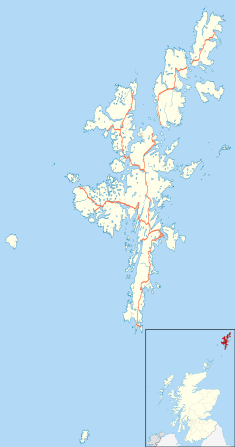Lunna House
| Lunna House | |
|---|---|

Lunna House
|
|
| Coordinates | 60°24′15″N 1°07′06″W / 60.4042°N 1.1182°WCoordinates: 60°24′15″N 1°07′06″W / 60.4042°N 1.1182°W |
|
Listed Building – Category B
|
|
| Designated | 13 August 1971 |
| Reference no. | 18591 |
| Designated | 2003 |
Lunna House is a 17th-century laird's house on Lunna Ness in the Shetland Islands. Lunna House is noted for having "the best historic designed landscape in Shetland". In the 20th century it was used as a base of the wartime Shetland Bus operation.
The house is protected as a category B listed building, and the grounds are included in the Inventory of Gardens and Designed Landscapes in Scotland, the national listing of significant gardens.
The earliest part of Lunna House was built in 1660, possibly on the site of a medieval haa (hall), for Robert Hunter (d.1695). Robert was Chamberlain of the Lordship of Zetland, and a Commissioner of Supply. An armorial panel on the house commemorates the 1707 marriage of his son Thomas Hunter and Grisella Bruce, around which time this part of the house was added. In 1753, nearby Lunna Kirk was built by Robert Hunter (1710–1777), 3rd laird.
The formal landscape around the house was laid out during the 18th century, and augmented in the 19th century with Gothic ornaments, such as the beach cobble finials of the gates to the south-west of the house. On the hilltop beyond the gates is a small folly, known as Hunter's Monument, which terminates the axis, and was formerly used as a lookout by the lairds. The harbour was also constructed in the 19th century, along with a walled garden and a lime kiln.
In 1845 Robina Hunter inherited the property. The following year she married Robert Bell, Sheriff at Lerwick, and a son of the surgeon Joseph Bell. Their son Robert Bell Hunter, 8th Laird of Lunna, sold the property in 1893 to John Bruce of Sumburgh. Bruce had the house extended in the 20th century.
During the Second World War, Lunna House became a base for the Shetland Bus, a clandestine operation to transfer men and materials between Shetland and Nazi-occupied Norway. The sheltered harbour at Lunna, away from populated areas, was considered ideal. Lieutenant David Howarth set up his headquarters at Lunna House, which was used as accommodation for the boat crews.
...
Wikipedia

